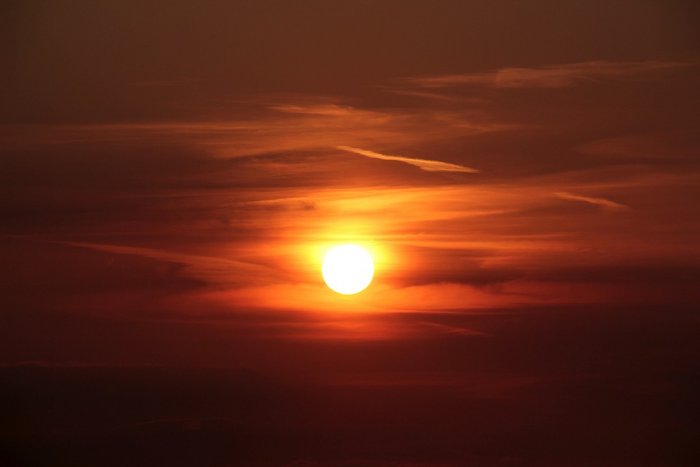Our Sun Is Shrinking And Growing But We Don’t Know Why
We depend on our Sun. Without it there would be no life on our planet. So, it’s vital to study the Sun and understand why certain processes occur.
One of the greatest and oldest astronomical problems is how we can conduct accurate measurement of the solar radius and its variations. Scientists have observed that our Sun is shrinking and growing every 11 years by 1 to 2 kilometers (0.6-1.2 miles), but we don’t know why.

Our Sun Is Shrinking And Growing But We Don’t Know Why
In their science paper, researchers wrote that “the solar radius and, more generally, shape variations reflect still poorly understood physical processes associated with the cyclic magnetic activity, which occur in the Sun’s interior and affect the surface.”
What is known is that the “first accurate measurements of the size of the Sun performed in 18th and 19th centuries indicated that “the systematically larger diameters correspond to the time when the number of spots and protuberances is lower.”
Nevertheless, despite several studies it is still debated whether the solar radius is constant or not. Spacecraft and ground-based instruments have delivered conflicting results and scientist cannot agree on the issue.
According to IFL Science, it almost like our Sun is breathing very slowly. “It’s a very faint “inhale” and “exhale” though, with those extra kilometers increasing the radius of the Sun by just 0.00029 percent at most, “IFL Science writes.
This process happens during the solar cycle. Every 11 years. The Sun’s magnetic field completely flip and our star’s north and south poles switch places.
Then it takes about another 11 years for the Sun’s north and south poles to flip back again.
During the solar cycle there is an increased activity on the surface of the Sun and magnetic fields create sunspots. As the magnetic fields change, so does the amount of activity on the Sun’s surface.
Giant eruptions on the Sun, such as solar flares and coronal mass ejections, also increase during the solar cycle.
The largest solar flares are classified as x-class flares and can produce as much energy as a billion hydrogen bombs! Giant solar flares can be dangerous. When huge solar flares are directed at our planet, they can create long lasting radiation storms that can harm satellites, communications systems, and even ground-based technologies and power grids. People are not expected to be in any danger, but studies show solar flares do cause changes in human health.
As previously mentioned on MessageToEagle.com, “the Sun’s activity as it interacts with the Earths magnetic field, effects extensive changes in human beings perspectives, moods, emotions and behavioral patterns.
“The idea that spots on the sun or solar flares might influence human health on earth at first appears to lack scientific credibility.
See also:
Can You Be Allergic To Sunlight?
New Evidence Our Sun Had A Twin – What Happened To Nemesis?
Another Solar Flare In ‘Carrington’ Class Could Destroy Our Civilization
However, when significant correlations between hospital admissions and health registers and Solar-Geomagnetic Activity (S-GMA) are found, then the challenge is to conceive of and to document a scientifically plausible and observationally supported mechanism and model. There is a large body of research correlating S-GMA with biological effects and human health effects.
There is currently an absence of a known and credible biophysical mechanism to link the S-GMA with these effects,” writes Dr Neil Cherry Associate Professor of Environmental Health at the Lincoln University in his science paper.”
According to the recent study conducted by researchers from the Center for Computational Heliophysics, New Jersey Institute of Technology there is a small change in solar dimensions that currently cannot be explained.
Though our shapeshifting Sun doesn’t seem to be major concern just, we must still keep a constant eye on what’s happening to our star.
Perhaps NASA’s Parker Solar Probe will deliver some answers. It is the first NASA’s mission of this kind. The car-sized spacecraft will study the Sun closer than any human-made object ever has.
Using Venus’ gravity, the Probe will gradually get closer to the sun over the course of 7 years. The Probe will fly to the sun’s corona, providing the closest observations of a star to date. The main mission goals are to understand how energy and heat move through the corona and learn what accelerates the solar wind and energetic particles.



 Creators of mankind
Creators of mankind Description of “Tall white aliens”
Description of “Tall white aliens” Where they came from?
Where they came from? About hostile civilizations
About hostile civilizations The war for the Earth
The war for the Earth “Tall white aliens” about eternal life
“Tall white aliens” about eternal life Video: “Nordic aliens”
Video: “Nordic aliens” Aliens
Aliens Alien encounters
Alien encounters The aliens base
The aliens base UFO
UFO Technology UFO
Technology UFO Underground civilization
Underground civilization Ancient alien artifacts
Ancient alien artifacts Military and UFO
Military and UFO Mysteries and hypotheses
Mysteries and hypotheses Scientific facts
Scientific facts


















